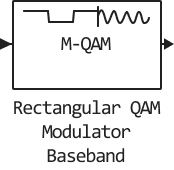Rectangular QAM Modulator Baseband
Modulation using rectangular quadrature amplitude modulation.
blockType: RectangularQAMModulator
|
Path in the library: |
Description
The Rectangular QAM Modulator Baseband block modulates the input signal using quadrature amplitude modulation with constellation on a rectangular grating. The output is a basic representation of the modulated signal.
|
All power values assume a nominal impedance of 1 ohm. |
Ports
Parameters
Main
M-ary number - modulation order
16 (by default) | positive integer
Modulation order specified as a positive integer equal to a power of two. The modulation order determines the number of points in the signal constellation.
Input type - input type
Integer (by default) | Bit
Input type, specified as Integer or Bit to indicate whether the input signal consists of integers or groups of bits.
-
Integer- the input signal must consist of integers in the range , where is the modulation order, the value of the M-ary number parameters. -
Bit- the input signal must contain binary values, and the number of strings must be an integer multiple of
Constellation ordering - character ordering
Gray (by default) | Binary | User-defined
Defines how the block maps each character to a group of output bits or an integer.
Constellation mapping - User-defined constellation mapping
[0:15] (By default) | vector
A user-defined constellation mapping defined as an M-element vector containing unique integer values in the range , where is the modulation order, the value of the M-ary number parameters.
The first element of this vector corresponds to the uppermost leftmost point of the constellation, and subsequent elements follow the columns from left to right. The last element corresponds to the rightmost lower point.
Dependencies
This parameter appears when the Constellation ordering parameter is set to User-defined.
Normalisation method - scaling method for the constellation
Min. distance between symbols (by default) | Average Power | Peak Power
Constellation scaling method specified as Min. distance between symbols, Average Power or Peak Power.
Minimum distance is the distance between the two closest points of the constellation
2 (By default) | positive scalar
The distance between the two closest points of the constellation, given as a positive scalar.
Dependencies
This parameter appears when the Normalisation method parameters are set to Min. distance between symbols.
Average power, referenced to 1 ohm (watts) - average power
1 (By default) | `positive scalar'.
The average power of the symbols in the constellation in watts, specified as a positive scalar. Power values assume a nominal impedance of 1 ohm.
Dependencies
This parameter appears when the Normalisation method parameters are set to Average Power.
Peak power, referenced to 1 ohm (watts) - maximum power
1 (By default) | positive scalar
The maximum power of the symbols in the constellation in watts, specified as a positive scalar. Power values assume a nominal impedance of 1 ohm.
Dependencies
This parameter appears when the Normalisation method parameters are set to Average Power or Peak Power.
Phase offset (rad) - rotation of the signal constellation
0 (By default) | Scalar
Rotation of the signal constellation specified as a numeric scalar.
Algorithms
Signals with integer values and signals with binary values
If you set the Input type parameters to Integer, the block accepts integer values in the range . - is the modulation order specified by the M-ary number block parameter.
If the Input type parameter is set to Bit, the block accepts binary values representing integers. The block assembles binary digit signals into groups of bits, where is the number of bits per character and is the modulation order.
The length of the input vector must be an integer multiple of . In this configuration, the block takes a group of bits and maps it to a symbol at the block output. The block outputs one modulated character for each group of bits.
The Constellation ordering parameters specify how the block assigns binary words to signal constellation points. These assignments are applied independently to the in-phase and quadrature components of the input signal:
-
If the Constellation ordering parameters are set to
Binary, the block uses a binary-encoded constellation. -
If the Constellation ordering parameters are set to
Grayand is even, the unit uses a Gray-coded constellation. -
If the Constellation ordering parameters are set to
Grayand is odd, the block encodes the constellation so that pairs of nearest points differ by one or two bits. The constellation is cross-shaped, and the diagram below shows which pairs of points differ by two bits. The diagram uses , but assumes the general case.

Since the in-phase and quadrature components are assigned independently, the Gray code order and binary order are the same at .
Constellation size and scaling
The signal constellation consists of points, where is the value of the M-ary number parameters. must be of the form for some positive integer . The block scales the signal constellation depending on what value is set for the Normalisation method parameters.
| Value of the Normalisation method parameter | Scaling condition |
|---|---|
|
The closest pair of points in the constellation is separated by the value of the Minimum distance parameters. |
|
The average power of symbols in a constellation is the value of the parameter Average power, referenced to 1 ohm (watts). |
|
The maximum power of the symbols in a constellation is the value of the parameter Average power, referenced to 1 ohm (watts). |
